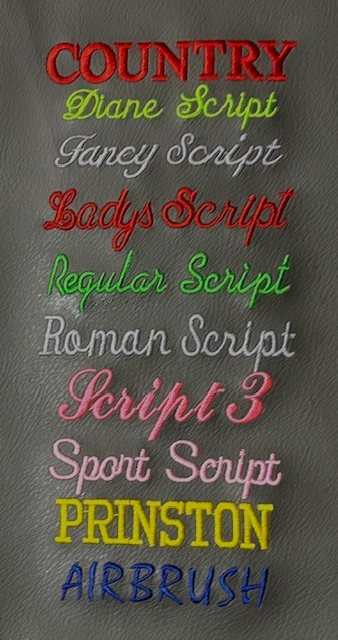Stylish Monogramming on Towels for a Touch of Deluxe
Stylish Monogramming on Towels for a Touch of Deluxe
Blog Article
The Art of Custom Needlework: Unlocking the Tricks to Creating Special and Remarkable Layouts
Embroidery, a craft steeped in tradition and virtuosity, holds within its intricate stitches the power to transform textile into a canvas of unique expression. The tricks to creating custom needlework styles that captivate the eye and leave a lasting impact hinge on a fragile balance of strategy, imagination, and interest to information. As we dig into the world of personalized needlework, we discover the nuanced interaction between string option, stitch complexity, and layout personalization that elevates a plain garment to a job of art. Join us on a trip through the art of custom-made needlework as we unravel the mysteries behind crafting truly extraordinary and distinct developments.
Choosing the Right Embroidery Threads
When choosing embroidery strings, what vital aspects should you take into consideration to make certain the finest outcomes for your customized designs? The choice of needlework thread is critical in determining the last result of your stitched layout.
Moreover, the weight or thickness of the thread plays a substantial role in the look of the needlework. Thicker strings can include dimension and appearance to your layout, while finer strings are perfect for intricate information and small text. Additionally, considering the shade fastness and washability of the thread is important to make sure that your custom layouts keep their high quality and vibrancy gradually. By carefully reviewing these elements and selecting top notch strings that satisfy your certain demands, you can improve the aesthetic allure and long life of your embroidered creations.
Discovering Various Stitch Strategies
To explore the realm of 'Exploring Different Stitch Techniques', one should grasp the details and subtleties that each stitching approach brings to the art of embroidery. Various stitch strategies not just include visual passion however additionally contribute to the total appearance and measurement of the style. One popular stitch method is the satin stitch, which includes very closely packed parallel stitches to produce a smooth and glossy surface, ideal for filling out shapes and creating vibrant outlines.
On the other hand, the backstitch is a functional method typically utilized for describing and including great information. It involves sewing backward to produce a strong line of needlework. In addition, the French knot stitch includes a responsive element to layouts, best for creating textured accents like flower centers or ornamental touches.
Discovering different stitch methods enables embroiderers to play with light, shadow, and depth within their styles, elevating the aesthetic appeal and imaginative high quality of their embroidery jobs. By understanding numerous sewing techniques, one can open countless opportunities for creating one-of-a-kind and remarkable custom-made needlework items.
Incorporating Personalized Layout Components
Having actually explored the details of different stitch strategies such as the satin stitch, backstitch, and French knot, the emphasis currently moves in the direction of including personalized layout aspects in custom embroidery tasks. Personalized design aspects play an essential function in making embroidery tasks genuinely distinct and memorable. One method to incorporate personalization is by including initials, names, or significant days to the design. This not just includes a customized touch but likewise boosts the sentimental value of the needlework item.
An additional More hints means to include customized style elements is by consisting of symbols or themes that hold special significance to the recipient or show their rate of interests and individuality. For instance, incorporating a preferred flower, animal, or hobby-related icon can make the needlework design a lot more purposeful and tailored. In addition, choosing shades that resonate with the recipient or straighten with the desired motif can further improve the customization of the browse around this site embroidery task.
Grasping the Art of Color Control
One secret element of color sychronisation is understanding shade theory. This includes knowing exactly how different shades communicate with each other, the feelings they share, and exactly how they can be incorporated to produce visually enticing layouts. By using color theory concepts, embroiderers can create harmonious shade combinations that boost the total look of the style.
In addition, taking notice of contrast is vital in shade control. Using contrasting shades can help certain aspects of the layout pop, enhance clarity, and develop a visually vibrant needlework piece. By mastering the art of shade sychronisation, embroiderers can boost their styles and create unforgettable items that resonate with clients and audiences alike.
Enhancing Texture With Advanced Needlework Stitches

French knots, as an example, are best for including tiny, increased dots to your design, resembling the appearance of beads or producing a textured surface. Bullion knots, on the various other hand, can be used to produce twisted, ropelike components that include a luxurious feel to the embroidery. Seed sewing involves small, scattered stitches that can fill out locations with a speckled structure, while turkey work develops fluffy, dimensional accents similar to animal hair or foliage. Try out these sophisticated needlework stitches allows you to push the limits of traditional needlework and create absolutely distinct and aesthetically enticing structures in your designs.
Final Thought
In final thought, the art of custom-made needlework includes a combination of choosing the best threads, checking out numerous stitch techniques, incorporating personalized style aspects, mastering color control, and improving texture with innovative stitches. By recognizing and applying these crucial elements, embroiderers can create distinct and remarkable styles that display their imagination and ability. Embroidery lovers can open the secrets to developing attractive and custom pieces that stick out and leave an enduring perception.
Report this page